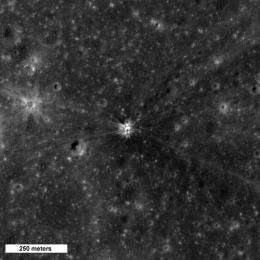The crater in the center of this image was formed by Apollo 14's Saturn IVB booster. The booster was intentionally impacted into the lunar surface on Feb. 4, 1971. The impact caused a minor "moonquake" that scientists used to learn about the moon's interior structure. Seismometers placed on the surface by Apollo astronauts returned data on the tremor. Credit: NASA/Goddard Space Flight Center/Arizona State University
(PhysOrg.com) -- A distinctive crater about 35 meters (115 feet) in diameter was formed when the Apollo 14 Saturn IVB (upper stage) was intentionally impacted into the moon. The energy of the impact created small tremors that were measured by the seismometer placed on the Moon by Apollo 12 astronauts in 1969.
The interior of the crater has bright mounds, and a bright ejecta blanket surrounds the exterior of the crater. Bright rays are observed to extend across the surface for more than 1.5 km (0.9 miles) from the impact. This LROC image was taken when the sun was relatively high in the sky, bringing out subtle differences in reflectivity or brightness. Scientists noted the unusual occurrence of dark and bright rays when the Apollo 16 spacecraft observed the site.
The upcoming LCROSS impact into the crater Cabeus will also be used to probe the lunar subsurface. The Apollo 14 impact was used to send vibrations through the surface to help scientists study the internal structure of the lunar crust, whereas the LCROSS impact will throw debris up into space so a trailing spacecraft and Earth-based telescopes can analyze its composition.
The Apollo impact velocity was at 5,682 mph. The booster component weighed 30,835 lbs at the time of impact, and the impact energy was equivalent to just over 10 tons of TNT. A seismometer placed in 1969 by Apollo 12 astronauts recorded the vibrations, which lasted for about three hours. The LCROSS impactor (the upper stage of a Centaur rocket) is much smaller than the S-IVB and thus will make a smaller crater. The Centaur weighs about 4,409 lbs and will hit with a velocity of about 5,592 mph.
Provided by JPL/NASA (news : web)






















